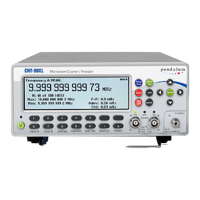one or more data bytes. When the queue
is empty, the queue status bit is set false.
Status of the Output Queue (MAV)
The MAV (message available) queue sta
-
tus message appears in bit 4 of the status
byte register. It indicates if there are bytes
ready to be read over the GPIB in the
GPIB output queue of the instrument.
The output queue is where the formatted
data appears before it is transferred to the
controller.
The controller reads this queue by ad
-
dressing the instrument as a talker. The
command to do this differs between dif
-
ferent programming languages. Examples
are IOENTERS and IBREAD.
Status of the Error Message Queue
(EAV)
The EAV (error message available)
queue status message appears in bit 2 of
the status byte register. Use the
:SYSTem:ERRor? query to read the er-
ror messages. Chapter 7 explains all pos-
sible error messages .
n
Using the Status Byte
The status byte is an eight bit status mes
-
sage. It is sent to the controller as a re
-
sponse to a serial poll or a *STB? query,
see Figure 6-3. Each bit in the status byte
contains a summary message from the
status structure. You can select what bits
in the status byte should generate a ser
-
vice request to alert the controller.
When a service request occurs, the
SRQ-line of the GPIB will be activated.
Whether or not the controller will react
on the service request depends on the
controller program. The controller may
be interrupted on occurrence of a service
request, it may regularly test the
SRQ-line, it may regularly make serial
poll or *STB?, or the controller may not
react at all. The preferred method is to
use SRQ because it presents a minimum
of disturbance to the measurement pro
-
cess.
Selecting Summary Message to Gen
-
erate SRQ
The counter does not generate any SRQ
by default. You must first select which
summary message(s) from the status byte
register should give SRQ. You do that
with the Service Request Enable com
-
mand *SRE <bit mask>.
Example:
*SRE816
This sets bit 4 (16=2
4
) in the service request
enable register (see Figure 6-4). This
makes the instrument signal SRQ
when a message is available in the
output queue.
RQS/MSS
The original status byte of IEEE 488.1 is
sent as a response to a serial poll, and bit
6 means requested service, RQS.
IEEE 488.2 added the *STB? query and
expanded the status byte with a slightly
different bit 6, the MSS. This bit is true
as long as there is unfetched data in any
of the status event registers.
–
The Requested Service bit, RQS, is set true
when a service request has been signalled.
If you read the status byte via a Serial Poll,
bit 6 represents RQS. Reading the status
byte with a serial poll will set the RQS bit
false, showing that the status byte has been
read.
–
The Master Summary Status bit, MSS, is
set true if any of the bits that generates
Using the Subsystems
Status Subsystem 6-13

